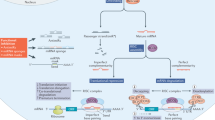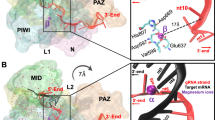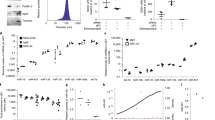Abstract
RNA interference (RNAi) is now an umbrella term referring to post-transcriptional gene silencing mediated by either degradation or translation arrest of target RNA. This process is initiated by double-stranded RNA with sequence homology driving specificity. The discovery that 21–23 nucleotide RNA duplexes (small-interfering RNAs, siRNAs) mediate RNAi in mammalian cells opened the door to the therapeutic use of siRNAs. While much work remains to optimize delivery and maintain specificity, the therapeutic advantages of siRNAs for treatment of viral infection, dominant disorders, cancer, and neurological disorders show great promise.
This is a preview of subscription content, access via your institution
Access options
Subscribe to this journal
Receive 12 print issues and online access
$259.00 per year
only $21.58 per issue
Buy this article
- Purchase on Springer Link
- Instant access to full article PDF
Prices may be subject to local taxes which are calculated during checkout


Similar content being viewed by others
References
Bernstein E, Denli AM, Hannon GJ . The rest is silence. RNA 2001; 7: 1509–1521.
Fire A et al. Potent and specific genetic interference by double-stranded RNA in Caenorhabditis elegans. Nature 1998; 391: 806–811.
Bartel D . MicroRNAs: genomics, biogenesis, mechanism, and function. Cell 2004; 116: 281–297.
Doench J, Petersen C, Sharp P . siRNAs can function as miRNAs. Genes Dev 2003; 17: 438–442.
Elbashir S, Lendeckel W, Tuschl T . RNA interference is mediated by 21- and 22-nucleotide RNAs. Genes Dev 2001; 15: 188–200.
Hammond SM, Bernstein E, Beach D, Hannon GJ . An RNA-directed nuclease mediates post-transcriptional gene silencing in Drosophila cells. Nature 2000; 404: 293–296.
Bernstein E, Caudy A, Hammond S, Hannon G . Role for a bidentate ribonuclease in the initiation step of RNA interference. Nature 2001; 409: 363–366.
Ketting RF et al. Dicer functions in RNA interference and in synthesis of small RNA involved in developmental timing in C. elegans. Genes Dev 2001; 15: 2654–2659.
Knight SW, Bass BL . A role for the RNase III enzyme DCR-1 in RNA interference and germ line development in Caenorhabditis elegans. Science 2001; 293: 2269–2271.
Zamore P, Tuschl T, Sharp P, Bartel D . RNAi: double-stranded RNA directs the ATP-dependent dleavage of mRNA at 21 to 23 nucleotide intervals. Cell 2000; 101: 25–33.
Schwarz DS et al. Asymmetry in the assembly of the RNAi enzyme complex. Cell 2003; 115: 199–208.
Martinez J et al. Single-stranded antisense siRNAs guide target RNA cleavage in RNAi. Cell 2002; 110: 563–574.
Stark G et al. How cells respond to interferons. Annu Rev Biochem 1998; 67: 227–264.
Elbashir S et al. Duplexes of 21-nucleotide RNAs mediate RNA interference in cultured mammalian cells. Nature 2001; 411: 494–498.
Sledz CA et al. Activation of the interferon system by short-interfering RNAs. Nat Cell Bio 2003; 5: 834–839.
Bridge A et al. Induction of an interferon response by RNAi vectors in mammalian cells. Nat Genet 2003; 34: 263–264.
Miller V et al. Allele-specific silencing of dominant disease genes. Proc Natl Acad Sci USA 2003; 100: 7195–7200.
Gonzalez-Alegre P, Miller V, Davidson B, Paulson H . Toward therapy for DYT1 dystonia: allele-specific silencing of mutant TorsinA. Ann Neurol 2003; 53: 781–787.
Faustino N, Cooper T . Pre-mRNA splicing and human disease. Genes Dev 2003; 17: 419–437.
Lewis DL et al. Efficient delivery of siRNA for inhibition of gene expression in postnatal mice. Nat Genet 2002; 32: 107–108.
Celotto A, Graveley B . Exon-specific RNAi: a tool for dissecting the functional relevance of alternative splicing. RNA 2002; 8: 718–724.
Cho J et al. Two isoforms of sarco/endoplasmic reticulum calcium ATPase (SERCA) are essential in Caenorhabditis elegans. Gene 2000; 261: 211–219.
Ge B et al. TAB1B (transforming growth factor-B-activated protein kinase 1-binding protein 1B), a novel splicing variant of TAB1 that interacts with p38α but not TAK1*. J Biol Chem 2003; 278: 2286–2293.
Ryther RCC et al. GH1 splicing is regulated by multiple enhancers whose mutation produces a dominant-negative GH isoform that can be degraded by allele-specific siRNA. Endocrinology 2004; 145: 2988–2996.
Kao S-C, Krichevsky A, Kosik K, Tsai L-H . BACE1 suppression by RNA interference in primary cortical neurons. J Biol Chem 2003; 279: 1942–1949.
Wood M, Trulzsch B, Abdelgany A, Beeson D . Therapeutic gene silencing in the nervous system. Hum Mol Gen 2003; 12: R279–284.
Zhang G, Budker V, Wolff J . High levels of foreign gene expression in hepatocytes after tail vein injections of naked plasmid DNA. Hum Gene Therapy 1999; 10: 1735–1737.
Song E et al. RNA interference targeting Fas protects mice from fulminant hepatitis. Nat Med 2003; 9: 347–351.
Zender L et al. Caspase 8 small interfering RNA prevents acute liver failure in mice. Proc Natl Acad Sci USA 2003; 100: 7797–7802.
Wilda M, Fuchs U, Wossmann W, Borkhardt A . Killing of leukemic cells with a BCR/ABL fusion gene by RNA interference (RNAi). Oncogene 2002; 21: 5716–5724.
Brummelkamp T, Bernards R, Agami R . Stable suppression of tumorigenicity by virus-mediated RNA interference. Cancer Cell 2002; 2: 243–247.
Cioca D, Aoki Y, Kiyosawa K . RNA interference is a functional pathway with therapeutic potential in human myeloid leukemia cell lines. Cancer Gene Ther 2003; 10: 125–133.
Jackson A et al. Expression profiling reveals off-target gene regulation by RNAi. Nat Biotechnol 2003; 21: 635–637.
Semizarov D et al. Specificity of short interfering RNA determined through gene expression signatures. Proc Natl Acad Sci USA 2003; 100: 6347–6352.
Stevenson M . Dissecting HIV-1 through RNA interference. Nat Rev Immun 2003; 3: 851–857.
Kitabwalla M, Ruprecht R . RNA interference – a new weapon against HIV and beyond. N Engl J Med 2002; 347: 1364–1367.
Silva J, Hammond S, Hannon G . RNA interference: a promising approach to antiviral therapy? TRENDS Mol Med 2002; 8: 505–508.
Gitlin L, Andino R . Nucleic acid-based immune system: the antiviral potential of mammalian RNA silencing. J Virol 2003; 77: 7159–7165.
Boden D et al. Human immunodeficiency virus type 1 escape from RNA interference. J Virol 2003; 77: 11531–11535.
Das A et al. Human immunodeficiency virus type 1 escapes from RNA interference-mediated inhibition. J Virol 2004; 78: 2601–2605.
Gitlin L, Karelsky S, Andino R . Short interfering RNA confers intracellular antiviral immunity in human cells. Nature 2002; 418: 430–434.
Lakatos L, Szittya G, Silhavy D, Burgyan J . Molecular mechanism of RNA silencing suppression mediated by p19 protein of tombusviruses. EMBO J 2004; 23: 876–884.
Czauderna F et al. Structural variations and stabilising modifications of synthetic siRNAs in mammalian cells. Nucleic Acid Res 2003; 31: 2705–2716.
Chiu Y-L, Rana T . siRNA function in RNAi: a chemical modification analysis. RNA 2003; 9: 1034–1048.
Amarzguioui M, Holen T, Babaie E, Prydz H . Tolerance for mutations and chemical modifications in a siRNA. Nucleic Acid Res 2003; 31: 589–595.
McCaffrey AP et al. RNA interference in adult mice. Nature 2002; 418: 38–39.
Sorensen DR, Leirdal M, Sioud M . Gene silencing by systemic delivery of synthetic siRNAs in adult mice. J Mol Biol 2003; 327: 761–766.
Calegari F et al. Tissue-specific RNA interference in postimplantation mouse embryos with endoribonuclease-prepared short interfering RNA. Proc Natl Acad Sci USA 2002; 99: 14236–14240.
Matsuda T, Cepko C . Electroporation and RNA interference in the rodent retina in vivo and in vitro. Proc Natl Acad Sci USA 2004; 101: 16–22.
Chou T, Biswas S, Lu S . Gene delivery using physical methods: an overview. Methods Mol Biol 2004; 245: 147–166.
Trezise A, Palazon L, Davies W, Colledge W . In vivo gene expression: DNA electrotransfer. Curr Opin Mol Ther 2003; 5: 397–404.
Zhang X et al. Small interfering RNA targeting heme oxygenase-1 enhances ischemia–reperfusion-induced lung apoptosis. J Biol Chem 2004; 279: 10677–10684.
Iascson R, Kull B, Salmi P, Wahlestedt C . Lack of efficacy of ‘naked’ small interfering RNA applied directly to rat brain. Acta Physiol Scand 2003; 179: 173–177.
Jacque J-M, Triques K, Stevenson M . Modulation of HIV-1 replication by RNA interference. Nature 2002; 418: 435–438.
Lee NS et al. Expression of small interfering RNAs targeted against HIV-1 rev transcripts in human cells. Nat Biotechnol 2002; 19: 500–505.
Coburn GA, Cullen BR . Potent and specific inhibition of human immunodeficiency virus type 1 replication by RNA interference. J Virol 2002; 76: 9225–9231.
Capodici J, Kariko K, Weissman D . Inhibition of HIV-1 infection by small interfering RNA-mediated RNA interference. J Immunol 2002; 169: 5196–5201.
Qin X-F, An DS, Chen ISY, Baltimore D . Inhibiting HIV-1 infection in human T cells by lentiviral-mediated delivery of small interfering RNA against CCR5. Proc Natl Acad Sci USA 2003; 100: 183–188.
Novina C et al. siRNA-directed inhibition of HIV-1 infection. Nat Med 2002; 8: 681–686.
Song E et al. Sustained small interfering RNA-mediated human immunodeficiency virus type I inhibition in primary macrophages. J Virol 2003; 77: 7174–7181.
Arteaga H et al. Choosing CCR5 or Rev siRNA in HIV-1. Nat Biotechnol 2003; 21: 230–231.
Martinez M et al. Suppression of chemokine receptor expression by RNA interference allows for inhibition of HIV-1 replication. AIDS 2002; 16: 2385–2390.
Hu W-Y et al. Inhibition of retroviral pathogenesis by RNA interference. Curr Biol 2002; 12: 1301–1311.
Park W-S, Hayafune M, Miyano-Kurosaki N, Takaku H . Specific HIV-1 env gene silencing by small interfering RNAs in human peripheral blood mononuclear cells. Gene Therapy 2003; 10: 2046–2050.
Boden D et al. Promoter choice affects the potency of HIV-1 specific RNA interference. Nucleic Acid Res 2003; 31: 5033–5038.
Hamasaki K et al. Short interfering RNA-directed inhibition of hepatitis B virus replication. FEBS 2003; 543: 51–54.
McCaffrey A et al. Inhibition of hepatitis B virus in mice by RNA interference. Nat Biotechnol 2003; 21: 639–644.
Wilson J et al. RNA interference blocks gene expression and RNA synthesis from hepatitis C replicons propagated in human liver cells. Proc Natl Acad Sci USA 2003; 100: 2783–2788.
Randall G, Grakoui A, Rice C . Clearance of replicating hepatitis C virus replicon RNAs in cell culture by small interfering RNAs. Proc Natl Acad Sci USA 2003; 100: 235–240.
Yokota T et al. Inhibition of intracellular hepatitis C virus replication by synthetic and vector-derived small interfering RNAs. EMBO Reports 2003; 4: 602–608.
Kapadia S, Brideau-Andersen A, Chisari F . Interference of hepatitis C virus RNA replication by short interfering RNAs. Proc Natl Acad Sci USA 2003; 100: 2014–2018.
Sen A et al. Inhibition of hepatitis C virus protein expression by RNA interference. Virus Res 2003; 96: 27–35.
Bitko V, Barik S . Phenotypic silencing of cytoplasmic genes using sequence-specific double-stranded short interfering RNA and its application in the reverse genetics of wild type negative-strand RNA viruses. BMC Microbiol 2001; 1: 34.
Ge Q et al. RNA interference of influenza virus production by directly targeting mRNA for degradation and indirectly inhibiting all viral RNA transcription. Proc Natl Acad Sci USA 2003; 100: 2718–2723.
Dector M, Romero P, Lopez S, Arias C . Rotavirus gene silencing by small interfering RNAs. EMBO Reports 2002; 3: 1175–1180.
Gaggar A, Shayakhmetov D, Lieber A . CD46 is a cellular receptor for group B adenoviruses. Nat Med 2003; 9: 1408–1412.
Jia Q, Sun R . Inhibition of gammaherpesvirus replication by RNA interference. J Virol 2003; 77: 3301–3306.
Jiang M, Milner J . Selective silencing of viral gene expression in HPV-positive human cervical carcinoma cells treated with siRNA, a primer of RNA interference. Oncogene 2002; 21: 6041–6048.
Bhoumik A et al. An ATF2-derived peptide sensitizes melanomas to apoptosis and inhibits their growth and metastasis. J Clin Invest 2002; 110: 643–650.
Hingorani S et al. Suppression of BRAFV599E in human melanoma abrogates transformation. Cancer Res 2003; 63: 5198–5202.
Yang G, Thompson J, Fang B, Liu J . Silencing of H-ras gene expression by retrovirus-mediated siRNA decreases transformation efficiency and tumor growth in a model of human ovarian cancer. Oncogene 2003; 22: 5694–5701.
Zhang L et al. Vector-based RNAi, a novel tol for isoform-specific knock-down of VEGF and anti-angiogenesis gene therapy of cancer. Biochem Biophys Res Commun 2003; 303: 1169–1178.
Denkert C et al. Induction of GO/G1 cell cycle arrest in ovarian carcinoma cells by the anti-inflammatory drug NS-398, but not by COX-2-specific RNA interference. Oncogene 2003; 22: 8653–8661.
Czauderna F et al. Inducible shRNA expression for application in a prostate cancer mouse model. Nucleic Acids Res 2003; 31: e127.
Davies J et al. Development of an siRNA-based method for repressing specific genes in renal organ culture and its use to show that the Wt1 tumour suppressor is required for nephron differentiation. Hum Mol Genet 2004; 13: 235–246.
Acknowledgements
This work was supported by the National Institutes of Health (DK035592 and GM62487). RCCR was supported by NIH 5T32 GM0347.
Author information
Authors and Affiliations
Rights and permissions
This article is cited by
-
Advances in siRNA delivery approaches in cancer therapy: challenges and opportunities
Molecular Biology Reports (2023)
-
Non-coding RNAs: the new central dogma of cancer biology
Science China Life Sciences (2021)
-
siRNA therapeutics: a clinical reality
Science China Life Sciences (2020)
-
Biogenesis and function of extracellular miRNAs
ExRNA (2019)
-
PIN1 transcript variant 2 acts as a long non-coding RNA that controls the HIF-1-driven hypoxic response
Scientific Reports (2019)



